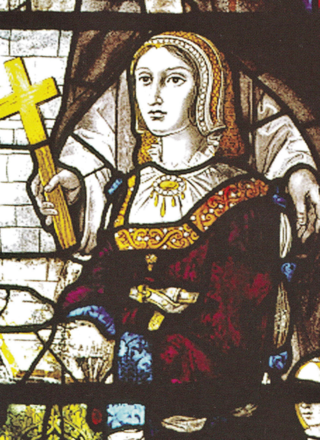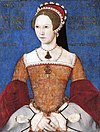
Felipe VI is King of Spain. He is the son of former King Juan Carlos I and Queen Sofía, and has two elder sisters, Infanta Elena, Duchess of Lugo, and Infanta Cristina. In 2004, Felipe married TV news journalist Letizia Ortiz with whom he has two daughters, Leonor and Sofía. In accordance with the Spanish Constitution, as monarch, he is head of state and commander-in-chief of the Spanish Armed Forces with the military rank of Captain General, and also plays the role of the supreme representation of Spain in international relations.

John II of Castile was King of Castile and León from 1406 to 1454. He succeeded his older sister, Maria of Castile, Queen of Aragon, as Prince of Asturias in 1405.

Prince or Princess of Asturias is the main substantive title used by the heir apparent or heir presumptive to the throne of Spain. According to the Spanish Constitution of 1978:
Article 57 [...] 2. The heir apparent or presumptive, from birth or event that makes him such, will have the dignity of Prince of Asturias and other titles traditionally linked to the successor of the Crown of Spain.

A crown prince or hereditary prince is the heir apparent to the throne in a royal or imperial monarchy. The female form of the title is crown princess, which may refer either to an heiress apparent or, especially in earlier times, to the wife of the person styled crown prince.
An heir presumptive is the person entitled to inherit a throne, peerage, or other hereditary honour, but whose position can be displaced by the birth of an heir apparent or a new heir presumptive with a better claim to the position in question.

Letizia Ortiz Rocasolano is the Queen of Spain as the wife of King Felipe VI. She came from a middle-class family and worked as a journalist for ABC and EFE before becoming a news anchor at CNN+ and Televisión Española. In 2004, she married Felipe, then Prince of Asturias and heir apparent to the Spanish throne. Their daughters, Leonor and Sofía, were born in 2005 and 2007 respectively. As Princess of Asturias, Letizia represented her father-in-law, King Juan Carlos, in Spain and abroad. On her father-in-law's abdication in June 2014, Felipe and Letizia became king and queen.
Infante, also anglicised as Infant or translated as Prince, is the title and rank given in the Iberian kingdoms of Spain and Portugal to the sons and daughters (infantas) of the king, regardless of age, sometimes with the exception of the heir apparent or heir presumptive to the throne who usually bears a unique princely or ducal title. A woman married to a male infante was accorded the title of infanta if the marriage was dynastically approved, although since 1987 this is no longer automatically the case in Spain. Husbands of born infantas did not obtain the title of infante through marriage, although they were occasionally elevated to the title de gracia at the sovereign's command.

The Prince or Princess of Girona is a title that was historically accorded to the heir apparent or heir presumptive to the Crown of Aragon. Current legislation mandates the title of Prince of Asturias to the heir of the Spanish throne but allows for the use of other traditional titles; the current title-holder, therefore, is Leonor, Princess of Girona.
The Spanish royal family consists of King Felipe VI, Queen Letizia, their children, and Felipe's parents, King Juan Carlos I and Queen Sofía. The royal family lives at Zarzuela Palace in Madrid, although their official residence is the Royal Palace of Madrid. The membership of the royal family is defined by royal decree and consists of: the King of Spain, the monarch's spouse, the monarch's parents, and the heir to the Spanish throne.

John, Prince of Asturias and Girona, was the only son of King Ferdinand II of Aragon and Queen Isabella I of Castile, and heir-apparent to both their thrones for nearly his entire life.

Leonor, Princess of Asturias is the heir presumptive to the throne of Spain as the elder daughter of King Felipe VI and Queen Letizia.

Isabella, Princess of Asturias was the eldest daughter and heir presumptive of King Ferdinand II of Aragon and Queen Isabella I of Castile. She was Queen of Portugal as the wife of King Manuel I from 30 September 1497 until her death the following year.

Maria of Castile was Queen of Aragon and Naples as the spouse of Alfonso V of Aragon. Maria acted as the regent of Aragon during the reign of her spouse, as he was absent during most of his reign; her regencies lasted between 1420 and 1423 and between 1432 and 1458. She was also briefly Princess of Asturias in her own right as the heir presumptive to the throne of Castile. She succeeded her father, Henry III of Castile, as Princess of Asturias in 1402.

Maria of Aragon was Queen of Portugal as the second spouse of King Manuel I, the widower of her elder sister Isabella.

The Prince or Princess of Viana is one of the titles of the heir of the Crown of Spain. Other associated titles originate from the rest of the kingdoms that formed Spain: Prince of Asturias, Prince of Girona, Duke of Montblanc, Count of Cervera and Lord of Balaguer.

Juan Pacheco, 1st Duke of Escalona, better known as Juan Pacheco, Marquess of Villena, was a Castilian noble of Portuguese descent who rose to power in the last years of the reign of Juan II of Castile and came to dominate the government of Castile during the reign of Juan II’s son and successor Henry IV of Castile. Created The 1st Duke of Escalona in 1472, his other titles included, among others, Marquess of Villena and Master of the Order of Santiago.

Eleanor of Castile was heir presumptive to the throne of the Crown of Castile and Princess of Asturias from 1424 until a few months before her death.

Infante of Spain is a royal title normally granted at birth to sons and daughters of reigning and past Spanish monarchs, and to the sons and daughters of the heir to the Crown. Individuals holding the title of infante also enjoy the style of Royal Highness.
























